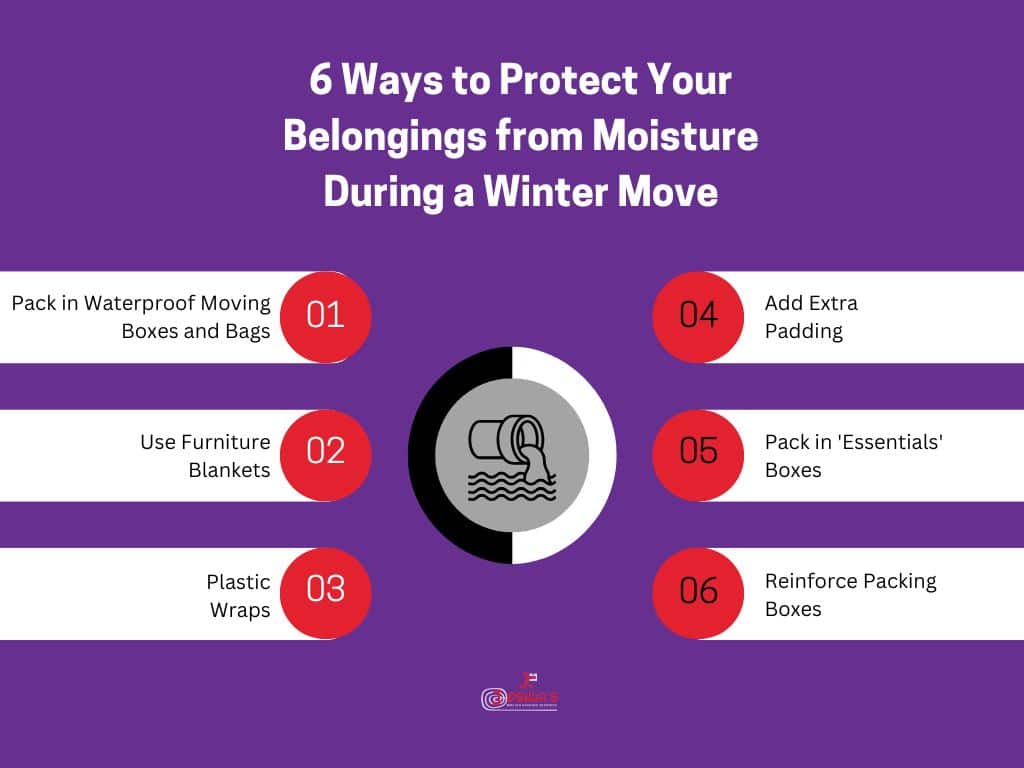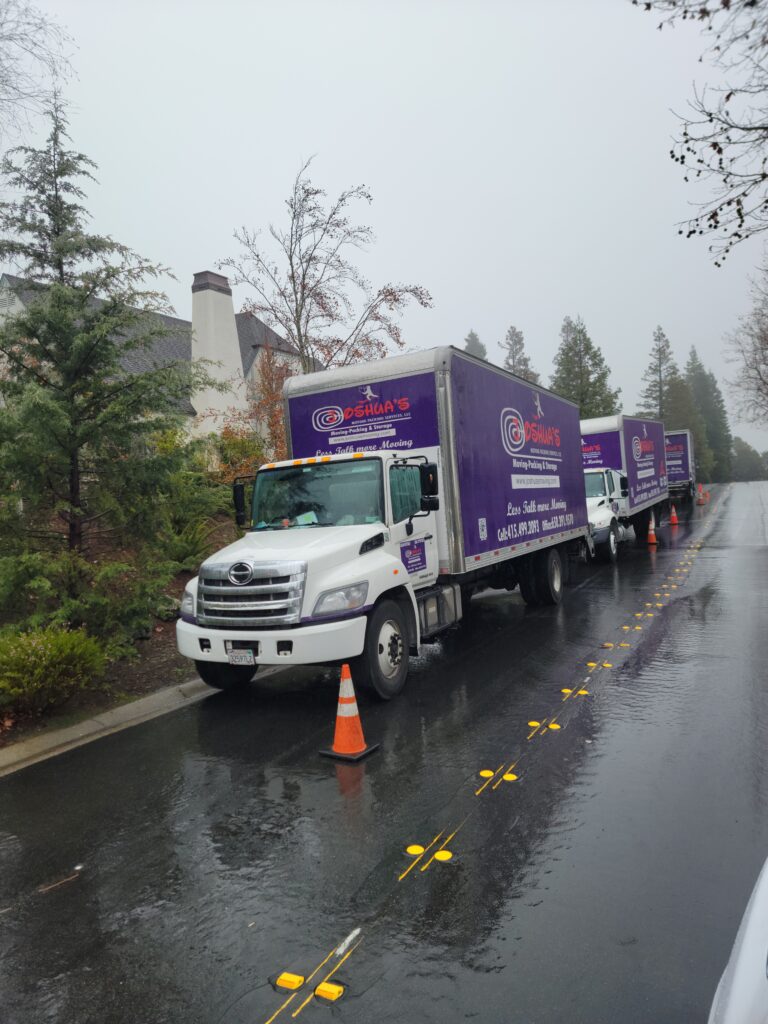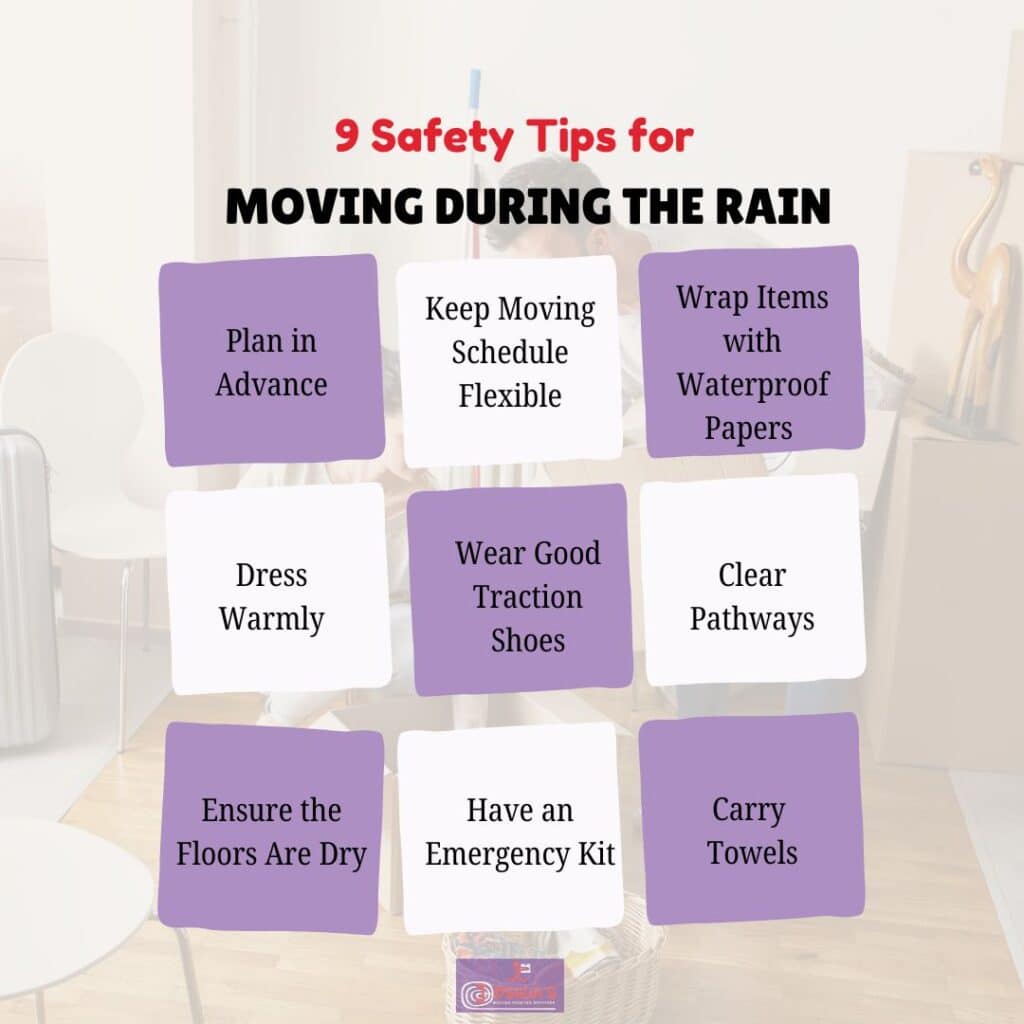Winter in the Bay Area is the opposite of conventional notions. While it’s rare to witness thick blankets of snow or ice, the city’s weather is variable. It can shift from unpredictable frequent rains to…

How to Prepare for a Move in the Bay Area Winter
February 6, 2025
Uncategorized
Winter in the Bay Area is the opposite of conventional notions. While it’s rare to witness thick blankets of snow or ice, the city’s weather is variable. It can shift from unpredictable frequent rains to misty fogs to mild temperatures within a minute, making moving in the Bay Area during winter stressful.
That said, key Bay Area relocation advice includes early preparation. Planning a move early minimizes delays or last-minute rushes. Additionally, timely preparation saves you stress, enhancing a smooth moving experience to your new home.
In this blog, you’ll discover the Bay Area’s winter weather, winter move preparation tips, contingency planning for delays, and how to move safely during rains. Let’s get started.
Table of Contents
- Understand Bay Area Winter Weather and Its Impact on Moving
- Protecting Your Belongings from Rain and Moisture
- Choose the Right Moving Company for Winter Conditions
- Plan for Traffic and Parking Challenges
- Safety Tips for Moving During the Rain
- Preparing Your New Home for a Winter Move
- Contingency Planning for Delays
- Hassle-free Winter Moving Services
Understand Bay Area Winter Weather and Its Impact on Moving

Unlike various U.S. cities, the Bay Area has a unique Mediterranean climate. Surprisingly, the city’s high rainfall is its version of snow. It’s not unusual to experience rainy, windy weather during winter instead of freezing, often in other locations such as Alaska or North Dakota.
Occasional windstorms are another common occurrence to keep in mind if you’re considering the Bay Area winter weather for moving. The city’s winter comes with mild, cool temperatures. Though rare, it can get snowy in higher elevation areas like San Jose due to its proximity to Mt. Hamilton.
The Bay Area weather impact on moving is notable, especially during the annual rains. The effects of rain and extreme wind on moving logistics are below.
1. Water Damage
Winter is the wettest season in the Bay Area. When moving during this time, rainwater can soak boxes housing furniture, important documents, or electronics, exposing your belongings to the risk of damage.
2. Loading and Offloading Challenges
Wet or rainy weather complicates loading and offloading your belongings safely. It can also increase moving costs because movers require more time and extra caution when loading and unloading to prevent damage.
3. Rust and Staining
Rainwater can penetrate exposed boxes, causing stains on upholstery and fabrics or rust in metallic households.
4. Traffic Navigation Issues
The Bay Area’s Heavy rains can cause flooding or road damage. Such issues result in traffic delays as moving trucks navigate damaged roads. Also, rain causes poor visibility, posing a risk, especially for long-distance moves.
5. Slippery Pathways and Floors
Wet weather is hazardous. It puts the movers at risk of falls as they move items on slippery surfaces, including pathways, corridors, and floors.
With proper planning and expert movers, you can enjoy moving despite the Bay Area’s tricky winter weather. One of the most practical rain season relocation tips includes checking your area’s weather forecast when planning a move. Choose the most favorable day with minimal rain projections and keep your moving dates flexible to accommodate extreme weather changes.
Protecting Your Belongings from Rain and Moisture
While you can’t control the Bay Area’s seasons, you can do various things to keep items dry when moving. The secret lies in how you pack your belongings. Whether you’re worried about your clothes, electronics, kitchenware, or furniture, proper wrapping and waterproofing are all you need to do for a safe move.
Here are some tips on how to protect your belongings from rain and moisture during a move:

1. Pack in Waterproof Moving Boxes and Bags
To protect belongings during rain, buy waterproof packing boxes and bags. Waterproof packaging ensures your households are safe from raindrops or wetness. Wrap your boxes with plastic bins, tarps, or plastic sheeting after packing if you don’t have waterproof bags or boxes.
2. Use Furniture Blankets
For large wooden furniture, utilize furniture covers or special waterproof blankets to protect the wooden pieces from water damage.
3. Plastic Wraps
Use plastic wrap to prevent water or moisture from destroying your furniture, artwork, photos, documents, and books. Furniture with wood finishes is sensitive to moisture and can undergo serious damage if not well covered.
4. Add Extra Padding
Cushion your belongings from pressure and moisture by putting more padding around them. Padding is crucial, especially when packing breakables. Ensure there’s little or no space between items by adding packaging papers, bubble wraps, foam, packing peanuts, or shredded papers.
5. Pack in ‘Essentials’ Boxes
Pack valuables and sensitive essentials, including jewelry, in separate boxes. Wrap them with a waterproof plastic wrap to keep them dry, and write “do not get wet” or “keep dry” on each box.
6. Reinforce Packing Boxes
Seal the boxes firmly with packing tape. Add an extra layer of tape to reinforce your boxes’ joints and corners and waterproof moving supplies.
Choose the Right Moving Company for Winter Conditions
Winter conditions in the Bay Area are unique. The weather is like none other, from heavy annual rainfalls to ‘Karl’ fogs to cool mild temperatures.
That said, contracting the best Bay Area movers in winter is an excellent idea because they understand the weather and terrain too well. Sample different quotations before settling on the one that suits your moving needs.
Some factors to consider when choosing a moving company for the rainy season are as follows:
1. Work Experience
Before settling on a company, research their experience in The Bay Area winter moving. Does your mover have expertise in rainproofing trucks, loading, offloading, and transporting belongings during winter months? You may ask the mover directly or look for online and offline customer reviews showing successful moves.
2. Licensing and Insurance
Check the permit documents of potential moving companies to ensure they are legally operating in the Bay area. In addition, check if the movers have insurance plans and compensations to protect your belongings against weather-related damage during a move.
3. Tools and Equipment

Moving during winter requires specialized equipment and water-resistant materials such as furniture blankets, snow tires, and safe-driving chains. You’ll have a seamless moving experience if you choose a mover with winter-specific tools and equipment.
4. Contingency Plans
Inquire from your mover what plans they have if there are weather delays or disruptions.
5. Packing Techniques
Find out if the mover’s packing methods are suitable for maximum protection of your belongings from moisture. How do they pack items? Which packing supplies do they use?
6. Price and Extra Fees
Before choosing movers for winter moves, request price quotes from different movers and compare them to see which suits your budget. Also, confirm if the company charges additional fees for delays and other weather-related issues.
Plan for Traffic and Parking Challenges
Since winter months come with heavy rainfall in the Bay Area, moving becomes daunting. Aside from the risk of damaged belongings, the wetness causes slippery surfaces, including roads and pathways. Further, the thick fog leads to poor visibility for moving truck drivers.
These conditions cause an increase in Bay Area traffic during the rainy season, leading to moving delays. Also, you’re likely to experience parking challenges during the winter months. While it’s easy to request a parking permit online, getting a legal space allocated for your moving truck takes time in winter, causing inconveniences.
To avoid traffic and parking issues, first, plan your winter relocation logistics. Secure parking permits in time and establish alternative routes if the roads are overcrowded.
Secondly, ensure you schedule your move during off-peak traffic hours. This way, you don’t have to stay stuck in non-flowing road traffic.
As you plan your move, ensure you work closely with a local licensed mover. Locals are familiar with the Bay Area roads and can easily navigate traffic snarl-ups.
Safety Tips for Moving During the Rain

Here’s how to move safely during the Bay Area winter:
- Plan in advance: The Bay Area’s winter is cool but unpredictable. Start planning your move early, as it leaves some time for adjustments if the weather conditions deteriorate.
- Flexibility: Keep your moving schedule flexible. Make it adjustable if the weather conditions change.
- Protect your households: wrap your items with waterproof papers to protect them from moisture damage. Additionally, rainproof the moving truck to keep your belongings dry during transit.
- Dress warmly: While it doesn’t get snowy, the Bay Area weather can be cold. Wear warm, weather-appropriate clothes, including heavy jackets, gloves, raincoats, and scarves. Carry extra clothes for change if you get wet.
- Wear good traction shoes: To avoid accidents while moving, wear anti-slip footwear. Shoes that aren’t firm-soled can cause slips and falls.
- Clear pathways: Remove debris, leaves, and other hazardous things from your pathways, walkways, or driveways. Clear paths are safe for you and your movers.
- Dry floors: Cover your home’s entrance with a rug or towel to keep floors dry. Covering your floor using plastic sheeting keeps rainwater off your home, preventing accidents.
- Have an emergency kit: Keep an emergency kit close by during winter moves. Pack essential items such as a torch, drinking water, batteries, warm clothes, snacks, and a first aid kit.
- Carry towels: keep a handful of towels ready. Towels come in handy for drying water or moisture from your belongings and surfaces.
Preparing Your New Home for a Winter Move
When preparing a new home, lay plastic sheeting, non-slip mats, or clean old towels at the entrance of your new home to prevent water, moisture, or mud from reaching your house. Also, create an offloading zone using a waterproof tarp. This way, your household items will be safe from water damage.
Turning your new home’s heater and electricity in advance is among the best winter set-up tips anyone will tell you. This ensures your house is warm and comfortable upon arrival.
Further, check drainage around your new property to ensure water flows freely. Also, clean gutters thoroughly to reduce water stagnation that can worsen the already cool California weather.
Contingency Planning for Delays
Prevalent heavy rains and thick fog can cause serious inconveniences including moving delays. Below are contingency planning for delays:
- Open communication: Have an open conversation with your mover regarding weather delays beforehand. Update your mover regularly about your moving plan and any potential changes to plans.
- Flexibility: This is key when handling moving delays. Schedule flexible moving dates and keep them open to adjustments in case of disruptive weather.
- Have backup plans for moving: create a practical backup plan detailing what to do if the rain becomes too much. Capture the tasks you plan to reschedule or postpone.
- Consider temporary storage: To resolve unexpected delays without compromising your items’ safety, you can store your belongings in temporary storage spaces until the weather is clear for moving.
Hassle-free Winter Moving Services
Since heavy rainfall falls in the Bay Area during winter, it’s challenging to move. But don’t let it worry you. With strategic, timely planning and the right moving company beside you, winter moves in the Bay Area are safe.
This Bay Area winter moving guide explains all you need to know when moving. From packing your belongings, planning for traffic delays, and choosing a moving company, we’ve provided proven stress-free moving tips for a seamless transition.
Get in touch with our experienced winter movers to relocate safely despite the city’s rainy winter.

